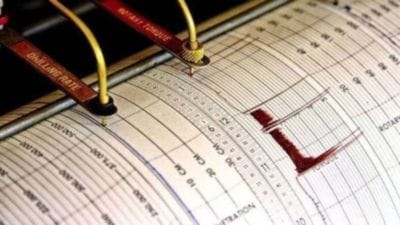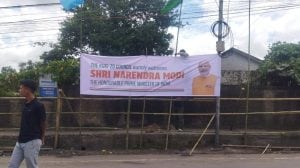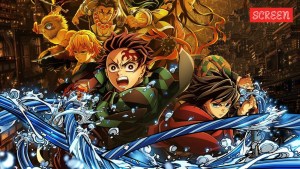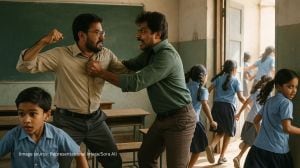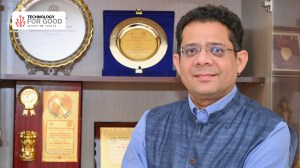Past sets trend for the future
It is most relevant that in January 2001, the citizens of Mumbai and its environs are treated to a visual panorama of one of the most sign...

It is most relevant that in January 2001, the citizens of Mumbai and its environs are treated to a visual panorama of one of the most significant phases of Indian Contemporary Art that of Bengal. The world is all set for the new millennium and in art, as in all fields, there is a sense of expectancy. To any individual Bengal conjures up an imagery of idealism, vibrancy, of Kali and Ramakrishna Paramahamsa, of Swami Vivekananda and Tagore. A cultural ethos that led to an outpouring of artistic expressions that combined the new with the old that was a synthesis of European techniques and established Indian expressions.
Colonisation brought in its wake new trends. Artists from Europe came in the 17th century to India fascinated by what they had heard. They brought with them training in art and concepts such as chiaroscuro, perspective, modernism, and cubism which they imparted to the locals who were fascinated by the innovative techniques. Travel to the west and trade exposed the Indian artists to works from Europe. Many of the royal patrons such as Satyaji Rao Gaekwar of Baroda, the Rajas of Travancore and Aundh to name just a few, brought works of European masters to India with the view of educating their subjects. With the changing climate local artists began to employ European motifs in their work the Kalighat patas displayed innovations, along with the regular motifs were introduced new designs, European men and women, ships, or driving in a horse carriage. The porous mind of the artist absorbed new imagery which was included in traditional art forms.
Thus, the India of the 18th and 19th centuries provided ample opportunities to artists who eagerly absorbed the new idioms and media and found patronage among the Westernised elite and British rulers. Calcutta was, in those days, a thriving settlement and as early as 1854, the first Industrial Art Society was set up which imparted formal training in the arts painting on canvas, landscape painting, portraiture, still life drawing, and clay modelling were taught. Among the great teachers were E B Havell, Abanindranath Tagore, A K Coomaraswamy and H H Locke. Calcutta was ‘‘a melting point of creative minds, ideas and cultural trends’’. Art formed a distinct identity of its own, it captured for posterity the mind and emotions of the artist of an unique environment reflecting a symbiosis of the West and the East.
Works of Hemen Mazumdar, the Tagores, Nandalal Bose and Jamini Roy reflect the sensibilities of artists who experimented with forms and used them successfully to express their innermost thoughts. The adoption of new colours and a freedom of the brush resulted in the development of powerful expressions that can be studied in the works of many of the Bengal masters. Every decade produced artists of merit and unbelievable talent and Bengal along with other centers of art such as Bombay, Madras, and Baroda placed Indian Contemporary Art on the world map.
As always the specially designed interiors of the Sir Cowasji Jehangir Public Hall of the NGMA lend themselves to the display of the many works that comprise the exhibition. The story unfolds with the depiction of Battala wood cuts and works of the early Bengal School that reflects a meeting of Mughal miniature tradition and European naturalism.
The works of Jamini Prakash Gangoli, Hemen Mazumdar reflect the sensitivity of those times. This period was followed by the Bengal Renaissance that created strong expressions, works of Abanindranath Tagore, Nandalal Bose, Ishwari Prasad Varma among others give an insight into how art progressed and created for itself an identity. The 1920s and 1930s were another ‘threshold.’ Masters like Rabindranath Tagore, Jamini Roy, Ramkinkar Baij, and Binode Behari Mukherjee broke away from established norms and developed a dynamic individualistic vocabulary. rapid changes were evident in the 40s, 50s and 60s Uma Sidhanta, Bhabesh Sanyal, Somnath Hore, Gobardan Ash, and K G Subramanyan were among the many who were a part of the revolution that was evident in the art scene. many societies were set up that directed to a great extent the development of modern art. the latter periods especially the 90s reflect that the artist had broken all barriers and created visions that moved from the traditional and folk to cyberexpressions. Art did not fall within predetermined boundaries and the expressions of each artist was unique reflecting inner angst and emotions.
The exhibition serves to document an important historical period of Indian art. It also offers an insight into the development of art, the influences and trends, and the psyche of the artist. The works spanning a period of 150 years show how art as a medium not only captures the mood of the artist but often reflects the political environment of the various periods. The past leads to the present which is the first step to the future. In art as in every other aspect of endeavour there are no perceptive boundaries it is for each one to set the trend.
(The author has been involved in the contemporary Indian art scene for over 30 years and is the owner of Cymroza Art Gallery at Warden Road)
Photos



- 01
- 02
- 03
- 04
- 05


